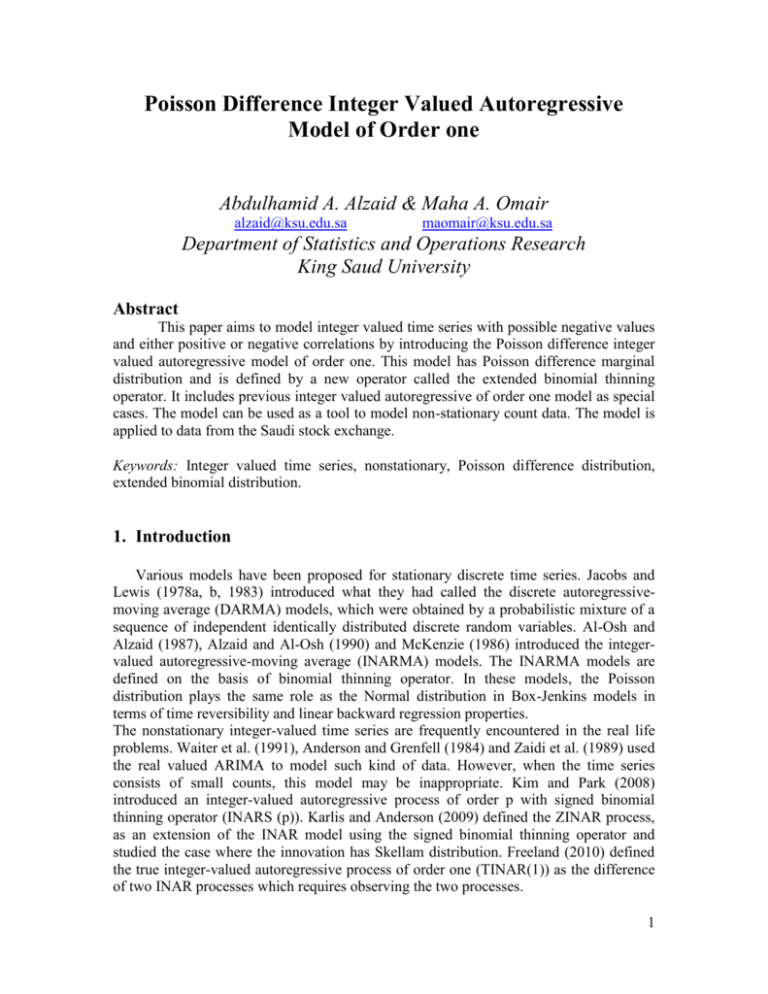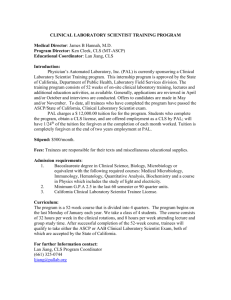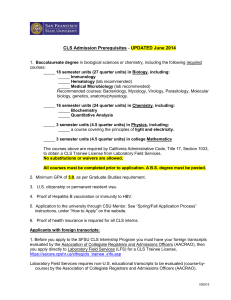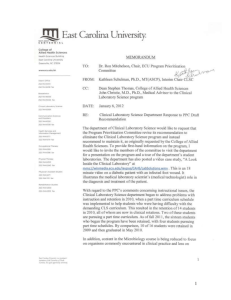Poisson Difference Integer Valued Autoregressive Model of Order one
advertisement

Poisson Difference Integer Valued Autoregressive
Model of Order one
Abdulhamid A. Alzaid & Maha A. Omair
alzaid@ksu.edu.sa
maomair@ksu.edu.sa
Department of Statistics and Operations Research
King Saud University
Abstract
This paper aims to model integer valued time series with possible negative values
and either positive or negative correlations by introducing the Poisson difference integer
valued autoregressive model of order one. This model has Poisson difference marginal
distribution and is defined by a new operator called the extended binomial thinning
operator. It includes previous integer valued autoregressive of order one model as special
cases. The model can be used as a tool to model non-stationary count data. The model is
applied to data from the Saudi stock exchange.
Keywords: Integer valued time series, nonstationary, Poisson difference distribution,
extended binomial distribution.
1. Introduction
Various models have been proposed for stationary discrete time series. Jacobs and
Lewis (1978a, b, 1983) introduced what they had called the discrete autoregressivemoving average (DARMA) models, which were obtained by a probabilistic mixture of a
sequence of independent identically distributed discrete random variables. Al-Osh and
Alzaid (1987), Alzaid and Al-Osh (1990) and McKenzie (1986) introduced the integervalued autoregressive-moving average (INARMA) models. The INARMA models are
defined on the basis of binomial thinning operator. In these models, the Poisson
distribution plays the same role as the Normal distribution in Box-Jenkins models in
terms of time reversibility and linear backward regression properties.
The nonstationary integer-valued time series are frequently encountered in the real life
problems. Waiter et al. (1991), Anderson and Grenfell (1984) and Zaidi et al. (1989) used
the real valued ARIMA to model such kind of data. However, when the time series
consists of small counts, this model may be inappropriate. Kim and Park (2008)
introduced an integer-valued autoregressive process of order p with signed binomial
thinning operator (INARS (p)). Karlis and Anderson (2009) defined the ZINAR process,
as an extension of the INAR model using the signed binomial thinning operator and
studied the case where the innovation has Skellam distribution. Freeland (2010) defined
the true integer-valued autoregressive process of order one (TINAR(1)) as the difference
of two INAR processes which requires observing the two processes.
1
The aims of this paper are to define a model that can handle nonstationary integer
valued time series, to model integer valued time series with possible negative values and
to model integer valued time series with either positive or negative correlations. The
paper is organized as follows. In section 2, we define the extended binomial thinning
operator. The Poisson difference integer valued autoregressive model of order one is
introduced in section 3. In section 4, we study the properties of the model and the
question of time reversibility. The estimation of the model parameters is discussed in
section 5. Section 6 includes applications from the Saudi stock exchange.
In the rest of this section we recall some definitions that are needed in the sequel.
Definition 1.1
Let X be a non-negative integer valued random variable, then for any 0,1
the "" binomial thinning operator which is due to Steutel and Van Harn (1979) is
defined by
X
X Yi
(1.1)
i 1
where Yi is a sequence of i.i.d. random variables, independent of X , such that
PYi 1 1 PYi 0 .
Al-Osh and Alzaid (1987) introduced the integer valued autoregressive process of
order one (INAR (1)).
Definition 1.2
The INAR (1) process X t ; t Z is defined by
X t X t 1 t
(1.2)
where 0,1 and t is a sequence of i.i.d. non-negative integer valued random
variables having mean and variance 2 .
Note that for any fixed parameter 0,1 and any non-negative integer valued
random variable X t , the random variables X t X t xt ~ Binomial xt , are assumed
to be independent of the history of the process and from the sequence t .
The INAR (1) process has many properties similar to the AR (1) process. For example,
any discrete self decomposable distribution can serve as a marginal distribution for the
INAR (1). The Poisson distribution almost plays the same role of the normal distribution.
Assuming that t is a sequence of i.i.d. Poisson then the process X t has Poisson
marginal distribution with mean 1 .
Kim and Park (2008) introduced an operator called the signed binomial thinning
to develop the INARS (p).
2
Definition 1.3
Let be a real number on 1, 1 and wtj be i.i.d. Bernoulli random
variables with P wtj 1 for each given t . Define sgn x 1 if x 0 and
sgn x 1 if x 0 . Using this notation, the signed binomial thinning is formally
defined as
yt
yt sgn sgn yt wtj
(1.3)
j 1
where the subscript t in wtj describes the observed time of process yt . When yt 0
and 0 , the signed binomial thinning is reduced to the binomial thinning operator.
Definition 1.4
The integer-valued autoregressive process of order p with signed binomial
thinning by Kim and Park (2008) is defined by
p
y t i y t i t ,
t 0,1,2,
(1.4)
i 1
where the signed binomial thinning operator is given in (3.17), t is a sequence of i.i.d.
integer-valued random variables with mean and variance 2 , 0 i 1 for
i 1,, p . The t are uncorrelated with yt i for i 1 and the counting series wtj in
the signed binomial thinning are i.i.d and independent of yt .
Under the condition that all roots of the polynomial p 1 p1 p1 p 0 are
inside the unit circle, the process yt is stationary and ergodic.
Karlis and Anderson (2009) studied (1.4) for p=1 and t has Skellam distribution.
However the marginal distribution of the process does not has Skellam distribution. They
computed the moment and conditional maximum likelihood estimates.
2. The Extended Binomial Operator
It is well known that given two independent Poisson random variables the conditional
distribution of one of them given their sum has binomial distribution. This idea was the
basis for defining the INAR models. Recently, Alzaid and Omair (2012) extended this
result to the case where the two independent random variables are Poisson difference
random variables and called the conditional distribution as the conditional Poisson
difference distribution. A special case of this distribution was considered and named as
the extended binomial distribution. In an analogy to the INAR models we will use the
result of Alzaid and Omair (2012) to introduce INAR model with Poisson difference
marginal distributions.
For ease of reference, the definition of the Poisson difference distribution and the
extended binomial distribution are given.
3
Definition 2.1:
A random variable Z is said to have Poisson difference (Skellam) distribution
with parameters 1 0 and 2 0 if its probability mass function (p.m.f.) is given by:
P( Z z ) e
1 2
1
2
z 2
I z 2 1 2
, z ,1,0,1,
(2.1)
k
x2
y
x 4
where I y x
is the modified Bessel function of the first kind.
2 k 0 k! y k !
The Poisson difference distribution is denoted by PD( 1 , 2 ).
Let X 1 and X 2 be two independent Poisson random variables with means 1 0 and
2 0 , respectively. Let Yi X i W , i 1,2 where W is a random variable
independent of X and X 2 . Then Z Y1 Y2 X 1 X 2 is PD( 1 , 2 ).
1
Alzaid and Omair (2010) introduced the following alternative formulas for the
probability mass function of the Poisson difference distribution
~
PZ z e 1 2 1z 0 F1 ; z 1;1 2
, z ,1,0,1,
~
using the regularized hypergeometric function 0 F1 , which is defined by
k
~
0 F1 ; y;
(2.2)
k! y k
This function is linked with the modified Bessel function of the first kind through the
identity
y
2
~
(2.3)
I y 0 F1 ; y 1;
4
2
k 0
Definition 2.2
A random variable X in Z has extended binomial distribution with parameters 0
( q 1 p ), 0 and z Z , denoted by X ~ EBz, p, if
~
~
p x q z x 0 F1 ; x 1; p 2 0 F1 ; z x 1; q 2
P X x
x ,1,0,1,
~
F
;
z
1
;
0 1
For X ~ EBz, p, :
I. The characteristic function:
~
it
it
1 2 pq
z 0 F1 ; z 1; pqe pqe
it
X t pe q
.
~
0 F1 ; z 1;
II. The mean:
E X pz .
III. The variance:
~
0 F1 ; z 2;
V X zpq 2 pq ~
0 F1 ; z 1;
p 1
(2.4)
(2.5)
(2.6)
(2.7)
4
Next, we will introduce a new operator which will be used in defining the PDINAR (1)
model.
Definition 2.3
Let Z be an integer-valued random variable (which can take negative integers); then for
any 0,1 and 0 the extended binomial thinning operator denoted by " S , Z " is
defined such that S , Z Z ~ EBZ , , .
The extended binomial thinning operator has the following representation
Z
W Z
i 1
i 1
S , Z sgn Z Yi
B ,
i
(2.8)
where Yi is a sequence of i.i.d. random variables, independent of Bi , Z and W Z , such
that PYi 1 1 PYi 0 , {Bi } is a sequence of i.i.d. random variables
independent of {Yi }, Z and W Z such that
PBi 1 PBi 1 1 and PBi 0 1 2 1
and W Z Z z is a random variable having Bessel distribution with parameters z , ,
(see, for example, Devroye (2002)).
Since
Z
W Z
i 1
i 1
Yi Z z ~ binomial z , ,
B Z z
i
has the distribution with characteristic
function given by
~
it
it
1 2
0 F1 ; z 1; e e
, where 1 and since they are
t
~
0 F1 ; z 1;
independent it is clear that S , Z Z z ~ EBz, , . See Alzaid and Omair (2012).
Remarks
I. The extended binomial thinning includes the binomial thinning as a special case
when Z is non-negative integer valued random variable and 0 .
II. The extended binomial thinning operator multiplied by a sign yields the binomial
signed operator of Kim and Park (2008) as a special case when 0 as we will
see in the next section.
3. The Poisson Difference Integer Valued Autoregressive Model of
Order One
In this section, we will define a new integer-valued autoregressive process of
order one that can handle negative integer-valued time series and allow for both positive
and negative autocorrelation. This process is called Poisson difference integer-valued
process (PDINAR(1)). Unlike the PINAR (1) where only positive correlation is obtained,
in the PDINAR (1) process we can model processes with positive and negative
correlation. We will use the notation PDINAR+ (1) for the process with positive
correlation and PDINAR- (1) for the process with negative correlation.
5
Definition 3.1
Let t be a sequence of i.i.d. random variables with the Poisson difference
distribution PD1 , 2 . The PDINAR (1) process Z t is defined by
Z t S , Z t 1 t
t 0, 1, 2, ,
(3.1)
where S , Zt is a sequence of i.i.d. integer-valued random variables that arise from
Z t by the extended binomial thinning and are assumed to be independent of the history
of the process and from the sequence t . δ is a parameter with possible values 1 and -1
describing the sign of the correlation.
Throughout we denote by PDINAR+ (1) or PDINAR- (1) to the PDINAR (1) according to
the value of δ is 1 or -1 respectively.
2
2
1 1 2 1 2
Let S , Zt Zt ~ EBZt , , such that 0,1 ,
.
4 1 1
1 2 1 2 1 1 2 1 2
It is also assumed that Z 0 ~ PD 1
,
. According
1 2 1
1
2 1
to the above definition, the process is Markovian.
The following proposition is proved in Alzaid and Omair (2012).
Proposition 3.1
If Z ~ PD1,2 and X Z z ~ EBz, p, , where 1 2 then X and Z X are
independent and X ~ PD p1, p2 and Z X ~ PDq1 , q2 .
Proposition 3.2
Under all the above conditions, the PDINAR (1) process is a stationary Markov
process with the Poisson difference marginal distribution having parameters
1 1 2 1 2 1 1 2 1 2
,
.
1 2 1
1
2 1
Proof
Case I:
When 1 , the process is PDINAR+ (1).
According to Proposition 3.1,
1 2 1 2
1 2 1 2 2
and
if Z 0 ~ PD 1
1 , 1
1 1 2 1
1 1
2 1
1 2
,
S , Z 0 Z 0 ~ EB Z 0 , , 1 2 2 , then S , Z 0 ~ PD
.
1
1 1
1 2
Since S , Z 0 ~ PD
,
is independent of 1 ~ PD1,2 and the sum of two
1 1
independent Poisson difference random variables is Poisson difference random variable,
6
we conclude that Z1 has the Poisson difference distribution with parameters
1
and
1
2
. That is Z1 has the same distribution as Z 0 . Since the process is Markovian Z t
1
is stationary PD 1 , 2 .
1 1
Case II :
When 1 , the process is PDINAR- (1).
According to Proposition 3.1,
1 2 1 2 1 2 1 1 2 1 2 2 1
and
if Z 0 ~ PD 1
,
1 1 2 2 1
1 1 2
2 1
2 2 1
then
S , Z 0 Z 0 ~ EB Z 0 , , 1
2
2
1 1
2 2 1
S , Z 0 ~ PD 1
,
.
2
1 2
1
2 2 1
Since S , Z 0 ~ PD 1
,
is independent of 1 ~ PD1,2 ,
2
1 2
1
Z1 has the Poisson difference distribution as the difference of two independent Poisson
2
1
difference distributions with parameters 1
and 2
. That is Z1 has the
2
1
1 2
same distribution as Z 0 . Since the process is Markovian, Z t is stationary
2 2 1
PD 1
,
.
2
1 2
1
4. Properties of the PDINAR (1) model
In this section, we discuss some distributional properties of the PDINAR (1) model.
1. The conditional mean is
E Z t Z t 1 Z t 1 1 2
(4.1)
and hence it is linear in Z t 1 .This implies that the PDINAR (1) model can be viewed
as a new member of the conditional linear model of Grunwald et al (2000).
2. The conditional variance is given by
~
0 F1 ; Z t 1 2;
V Z t Z t 1 1 Z t 1 2 1 ~
1 2 ,
(4.2)
F
;
Z
1
;
0 1
t 1
7
1 2
1
2
2
2
1 1 2 1 2
1
where
4 1 1 1 2 2 1
1
1 2 1 2
which is clearly not linear.
3. The unconditional mean is given by
2
.
E Z t 1
1
4. The unconditional variance is given by
2
V Z t 1
.
1
5. For any k 0,1,2,, the covariance is given by
k CovZ t k , Z t CovS , Z t k 1 t k , Z t
(4.3)
(4.4)
ECovS , Z t k 1 t k , Z t Z t k 1 CovES , Z t k 1 t k Z t k 1 , EZ t Z t k 1
CovE S , Z t k 1 t k Z t k 1 , EZ t Z t k 1 CovZ t k 1 , Z t CovZ t , Z t
k
k 2
1
.
1
6. The autocorrelation is
k CorrZ t k , Z t k .
We can see that the autocorrelation function decays exponentially.
7. The one step ahead predictive distribution is
(4.5)
(4.6)
t
i (1 ) z
t 1 i
~
~
~
e 1 21zt i 0 F1 ; i 1; 0 F1 ; zt 1 i 1; 0 F1 ; zt i 1;1 2
~
0 F1 ; zt 1 1;
1 2 1 2
where 1
4 1 1
2
2
.
Remarks:
1. The PDINAR+ (1) has the PINAR (1) as a special case when 2 0 . In the PDINAR+
(1), if 2 0 , then t is a sequence of i.i.d. random variables with Poisson distribution
Poisson1 and the extended binomial thinning operator S , Z reduces to the binomial
thinning operator since 2 0 implies that 0 .
2. If one defines a stationary Poisson difference INARS(1) process with positive
correlation, then one of the parameters of the Poisson difference distribution must be
zero, i.e it has either a Poisson distribution or the negative of a Poisson distribution. It
cannot be a difference of two Poisson distributions with nonzero parameters. Since in the
8
INARS(1) process
1 2
0 this implies that either 1 0 or 2 0 . It is
1 2
impossible to define a stationary Poisson difference INARS (1) process with negative
2 2 1
correlation since 1
0 implies that both 1 0 and 2 0 . We
2
2
1 1
mention that Kim and Park (2008) did not discuss the marginal distribution of their
process.
3. If 0 , the random variable S , Z t Z t has a degenerate distribution. In this case,
the PDINAR (1) reduces to a sequence of i.i.d. random variables PD1 , 2 .
Proposition 4.1
The Poisson difference integer-valued autoregressive process of order one with positive
correlation PDINAR+ (1) is time reversible.
Proof
Since the PDINAR+ (1) is a Markov process, it is enough to compute the bivariate
probability characteristic function Z t 1 , Z t u, v , which is of the form
Zt 1 ,Zt u, v E e iuZt 1 ivZt
E e iuZt 1 E e
ivS , Zt 1
Z t 1 t v
1 2
~
e iv e iv 1 2
0 F1 ; Z t 1 1;
2
Z t 1
1
v
E e iuZt 1 e iv
t
1 2
~
0 F1 Z t 1 1;
2
1
z
t 1
1 2
e iu e iv
e iu e iv 2 e iu e iv
0 F~1 ; z t 1 1; 1
e 1 1
z
1
1
1
t 1
e
e
1 2
1
1
e
1
eiu eiv 2 e iu e iv
1
t v
t
(4.7)
1 2
1 iu iv
1 2
e e 1eiu 2 e iu e iv 2e iu 1eiv 2e iv
1
1
1
e
where in (4.7) we used the identity
x
x
1 0
~
F1 ; x 1; 12 e 1 2 .
The bivariate characteristic function is a symmetric function in u and v , which implies
Z t , Z t 1 Z t 1 , Z t
d
and hence the process is time reversible. Moreover, since the
PDINAR (1) has linear forward regression it will have linear backward regression, that is
EZ t Z t 1 z EZ t 1 Z t z z 1 2 .
+
9
v
5. Estimation
Let us assume that we have n+1 observations z0 , z1 ,, z n from PDINAR (1) process. In
the PDINAR (1) model we have four parameters to be estimated , ,1 and 2 . Three
methods will be considered in this section, Yule-Walker method, conditional maximum
likelihood method and conditional least squares method. In all methods is estimated by
where
is the sample autocorrelation function.
1. Yule-Walker Method:
The simplest way to get an estimator for is to replace 1 with the sample
autocorrelation function r1 in the Yule-Walker equation and solve for to obtain
n 1
ˆ YW
z
r1
t 0
t
z z t 1 z
n
z
t 0
,
z
2
t
where z is the sample mean.
The following set of equations are used for estimating 1 and 2 :
2
and V Z t 1 2 .
E Z t 1
1
1
+
For the PDINAR (1), the Yule-Walker estimators are given by:
n 1
̂
YW
z
t 0
z z t 1 z
n
z
t 0
YW
,
z
2
t
1 ˆ z s ,
2
ˆ
1 ˆ z .
ˆ1YW
ˆ2YW
t
2
z
1YW
YW
For the PDINAR-(1), the Yule-Walker estimators are given by:
n 1
̂
YW
z
t 0
t
n
z
t 0
z
,
2
t
1
1 ˆ YW
z 1 ˆ YW
s z2 ,
2
ˆ1YW 1 ˆ YW
z.
ˆ1YW
ˆ2YW
z z t 1 z
10
2. The Conditional Maximum Likelihood CML Method:
The conditional likelihood for the PDINAR (1) model is defined by
For the PDINAR+ (1), the CML estimators for
,
and
maximizing the following conditional likelihood numerically
i (1 ) z
t 1 i
are obtained by
~
~
~
e 1 2 1zt i 0 F1 ; i 1; 21 2 /(1 ) 2 0 F1 ; z t 1 i 1;1 2 0 F1 ; z t i 1;1 2
~
2
0 F1 ; z t 1 1;1 2 /(1 )
For the PDINAR- (1), the CML estimators for
,
and
maximizing the following conditional likelihood numerically
i (1 ) z
t 1 i
are obtained by
~
~
~
e 1 2 1zt i 0 F1 ; i 1; 2 K 0 F1 ; z t 1 i 1; (1 ) 2 K 0 F1 ; z t i 1;1 2
~
0 F1 ; z t 1 1; K
2 2 1
where K 1
.
2
2
1 1
3. Conditional Least Squares Method:
The estimation procedure that we are going to apply was developed by Klimko and
Nelson (1978) with some modifications in order to be able to estimate all the parameters.
The Conditional least squares method is based on minimization of the sum of squared
deviations about the conditional expectation. The CLS estimator minimizes the criterion
function S1CLS given by
e Z
n
S1CLS
t 1
n
2
1t
t 1
t
E Z
t
Z t 1
Z
2
n
t 1
Z t 1 1 2 .
2
t
It is clear that differentiating S1CLS with respect to 1 and 2 and equating the resulting
expressions to zero give the same equation. Therefore, 1 and 2 are not estimable
directly. In order to estimate these parameters using conditional least squares method, we
will use the following reparametrization
1 2 , 2 1 2
11
and estimate all the three parameters , and 2 as follows.
For the first step, the conditional mean prediction error is considered
e1t Z t E Z t Z t 1 Z t Z t 1
n
The CLS estimators of and minimizes the criterion function S1CLS e12t .
t 1
From the first step we obtain
n
ˆ CLS ˆ
Z Z
t
t 1
,
n
Z
t 1
nZ Z 0
t 1
2
t 1
where Z
nZ 02
1 n
1 n
and
Z
Z
t
Zt1
0
n t 1
n t 1
ˆ CLS Z ˆ CLSˆZ 0 .
Note that in the case of PDINAR+ (1), ̂ CLS
and ̂ CLS
(when ˆ =1) are similar to the CLS
estimators of the PINAR (1) process.
To obtain an estimate of 2 a second step is needed. The normal equations based on the
conditional variance prediction error ( e2t ) are used. Brannas and Quoreshi (2010) used
the conditional variance prediction error as a second step to obtain feasible generalized
least square estimator for a long-lag integer-valued moving average model. The
conditional variance prediction error is defined by
2
e2t Z t E Z t Z t 1 V Z t Z t 1
The two proposed methods for estimating 2 are:
1. Method 1 :
n
From the fact that
e
t 1
2t
0 , one can obtain a direct estimator of 2 by solving the
nonlinear equation in the case of PDINAR+(1)
~
n
F1 ; Z t 1 2; A
2
0
eˆ1t ˆ CLS 1 ˆ CLS Z t 1 2ˆ CLS 1 ˆ CLS A ~
2 0 ,
t 1
0 F1 ; Z t 1 1; A
2
2
2
2
1 2 1 2
4 ˆ CLS
/ 4 1 ˆ CLS
where A 1
.
4 1 1
̂ CLS
and ̂ CLS
are those estimators obtained from the first step,
Z t 1 ˆ CLS
and eˆ1t Z t ˆ CLS
.
In the PDINAR- (1) process a direct estimator of 2 is obtained by solving the following
nonlinear equation
~
n
2
2
0 F1 ; Z t 1 2; B
0,
ˆ
ˆ
ˆ
ˆ
ˆ
e
1
Z
2
1
B
~
1
t
CLS
CLS
t
1
CLS
CLS
F
;
Z
1
;
B
t 1
0 1
t 1
where ̂ CLS and ̂ CLS are those estimators obtained from the first step,
12
1 2 1 2
B 1
4 1 1
2
and eˆ1t Z t ˆ
CLS
Z t 1 ˆ
CLS
2
2
1 ˆ CLS
4 1 ˆ CLS
2
4 1 ˆ CLS
ˆ
2
2
CLS
.
2. Method 2:
n
Minimize the criterion S2CLS e22t with respect to 2 by differentiating S2CLS with
t 1
respect to 2 and equating the result to zero, with ̂ CLS and ̂CLS as those estimators
obtained from the first step.
In the case of PDINAR+ (1)
~
n
S 2CLS
4 ˆ 2 CLS 0 F1 ; Z t 1 2; A
2
ˆ
ˆ
ˆ
ˆ
2{(e1t CLS 1 CLS Z t 1 CLS
2 )*
~
2
21 ˆ CLS 0 F1 ; Z t 1 1; A
t 1
~
ˆ CLS 0 F1 ; Z t 1 2; A
4 ˆ 2 CLS 2
ˆ
( 2
/ 41 ˆ CLS 2 *
1 ˆ CLS 0 F~1 ; Z t 1 1; A CLS 1 ˆ CLS
2
~
~
~
0 F1 ; Z t 1 1; A0 F1 ; Z t 1 3; A 0 F1 ; Z t 1 2; A
1)} 0
2
~
F
;
Z
1
;
A
0 1
t 1
By solving the last nonlinear equation, another estimate of 2 is obtained.
After estimating 2 either using the first or the second method, the CLS estimates of 1
and 2 are obtained from the following set of equations:
ˆ 1 / 2 ˆ 2 ˆ
1CLS
ˆ2CLS
1 / 2ˆ
CLS
2
CLS
CLS
ˆ CLS
.
In the case of PDINAR- (1)
~
n
S 2CLS
2
0 F1 ; Z t 1 2; B
ˆ
ˆ
ˆ
ˆ
ˆ
2{(e1t CLS 1 CLS Z t 1 2 CLS 1 CLS B * ~
2)*
2
t 1
0 F1 ; Z t 1 1; B
~
F ; Z 2; B
2
(ˆ CLS
* 0 ~1 t 1
1 ˆ CLS 0 F1 ; Z t 1 1; B
~
~
~
2
2 0 F1 ; Z t 1 1; B 0 F1 ; Z t 1 3; B 0 F1 ; Z t 1 2; B
ˆ CLS B
1)} 0
~
2
1 ˆ CLS
0 F1 ; Z t 1 1; B
By solving the last nonlinear equation, another estimate of 2 is obtained.
After estimating 2 either using the first or the second method, the CLS estimates of 1
and 2 are obtained from the following set of equations:
ˆ 1 / 2 ˆ 2 ˆ
1CLS
ˆ2CLS
1 / 2ˆ
CLS
2
CLS
CLS
ˆ CLS
.
13
The CLS estimates obtained using the first method and the second method will be
denoted by CLS (1) and CLS (2), respectively.
To provide an idea about the relative merits of each of the methods of estimation,
a Monte Carlo study is conducted. The estimation of , 1 and 2 in the stationary
PDINAR (1) by the Yule-Walker method, the conditional maximum likelihood and the
CLS using the two proposed method are compared. The conditional maximum likelihood
has an infinite sum, it was approximated to a finite one
(-50,50) since increasing this
bound to larger values made no difference. To generate the data, the parameters selected
are 1 , 2 1, 1,5, 5,2, 4 ,4 , 2 , 0.2, 0.5, 0.7 and n 50,100, 200 . 1000
replications were made on each sample, and the average bias and the mean square error
of the parameters’ estimates are calculated. All simulation and estimation procedures are
done using the Mathematica 8 software.
Steps of generation of PDINAR (1):
1. Generate n independent observations from PD1,2 which serves as t tn1 .
2. Generate one observation from
1 2 1 2 1 1 2 1 2
PD 1
,
and call it z0 .
1 2 1
1
2 1
3. Generate one observation from EBz 0 , , and call it S , z0 where
1
1 2 1 2
4 1 1
2
4.
5.
6.
7.
Let z1 S , z 0 1 .
2
.
Generate one observation from EBz1 , , and call it S , z1 .
Let z 2 S , z1 2 .
Repeat steps 5 and 6 until we obtain the nth observation zn .
Findings:
Regarding the MSE results we found that:
I. In the three methods of estimation, for both the models (PDINAR+(1) and
PDINAR-(1)), the MSE of each parameter is reciprocally related to the sample
size. The pace of decrease in the MSE as a result of increase in the sample size is
similar for all methods (the MSE would be reduced by about 50% if the sample
size is doubled).
II. The MSE of ̂ for both models in the Yule-Walker, CML and CLS estimates
decreases with the increase in .
III. The MSE of all estimates in the three methods are very close for both models. If a
ranking were to be made the CML would be first, followed by CLS (2), followed
by the CLS (1), and then the Yule-Walker method. The magnitude of gain, in
terms of MSE does not make it worth the extra calculations in the CML and CLS
methods.
14
Regarding the bias for the PDINAR (1) we can summarize as follows:
I. For the PDINAR+(1), in all cases, ̂ is biased negatively using all methods.
While for PDINAR-(1), when 0.5 and 0.7, ̂ is always biased negatively
using all methods and when 0.2 , ̂ is biased positively..
II. For the PDINAR+(1), the magnitude of the biases of ̂ increase with the increase
in using all methods except for some few cases of ˆ1 and ˆ2 . This is only true
for the PDINAR-(1) using the Yule-Walker method.
III. For the PDINAR+(1), the amount of biases of all estimates of ̂ is reciprocally
related to the sample size. This is not true for the PDINAR-(1).
IV. For both the models, the proposed methods of CLS estimation give close biases
of ˆ1 and ˆ2 . It has been noticed that for the PDINAR+(1)
bias ˆ1CLS 1 bias ˆ1CLS 2 bias ˆ2CLS 1 bias ˆ2CLS 2
in all cases.
Table 1 MSE () results of different estimation method for PDINAR (1) model (1=1, 2=1)
+
MSE ()
n
50
a
0.2
0.5
0.7
CML
0.01621
0.01909
0.01641
Y-W
0.02002
0.01998
0.01701
CLS
0.02058
0.01939
0.01880
100
0.2
0.5
0.7
0.009464
0.008547
0.006410
0.01002
0.00887
0.00707
0.01018
0.00874
0.00670
200
0.2
0.5
0.7
0.005225
0.004302
0.002987
0.00538
0.00450
0.00320
0.00540
0.00444
0.00309
+
Table 2 MSE (1) and MSE (2) results of different estimation method for PDINAR (1) model
(1=1, 2=1)
n
50
a
0.2
0.5
0.7
CML
0.07091
0.07375
0.07823
MSE (1)
Y-W
CLS(1)
0.07770 0.07670
0.07778 0.07479
0.08965 0.08018
100
0.2
0.5
0.7
0.03784
0.03594
0.03596
0.04012
0.03873
0.04038
0.03950
0.03736
0.03721
0.03926
0.037006
0.036984
0.03447
0.03256
0.03344
0.03651
0.034488
0.036897
0.036276
0.033948
0.034758
0.03608
0.03359
0.03459
200
0.2
0.5
0.7
0.01941
0.01738
0.01685
0.02005
0.01807
0.01788
0.01994
0.01786
0.01723
0.019883
0.01775
0.017177
0.01801
0.016265
0.015699
0.0185826
0.017001
0.016758
0.018626
0.016936
0.016272
0.01855
0.016786
0.016184
CLS(2)
0.07652
0.07435
0.07986
CML
0.08331
0.08339
0.0857
MSE (2)
Y-W
0.08838
0.08753
0.0965
CLS(1)
0.08722
0.083995
0.0863
CLS(2)
0.08699
0.08369
0.0862
15
6. Applications
In this section we present an application of the PDINAR (1) model from the Saudi stock
market. In 2007, the minimum amount of change was SR 0.25 for all stocks. The daily
close price as number of ticks (ticks=close price*4) in 2007 for Saudi
Telecommunication Company (STC) stock and the Electricity stock are considered. The
time series plots of the two stocks are illustrated in Figures 1 and 2 respectively. The
autocorrelation function (ACF) and the partial autocorrelation function (PACF) for STC
and Electricity are shown in Figures 3-6.
Time Series Plot of no. of ticks of STC closed price
Time Series Plot of no. of ticks of Electricity closed price
360
65
no of tick of closed price
no of tick of closed price
340
320
300
280
260
60
55
50
240
45
220
1
25
50
75
100
125
day
150
175
200
225
1
Figure 1 Time series plot of STC
25
100
125
day
150
175
200
225
Autocorrelation Function for no. of ticks of closed price of electricity
(with 5% significance limits for the autocorrelations)
(with 5% significance limits for the autocorrelations)
1.0
1.0
0.8
0.8
0.6
0.6
0.4
0.4
Autocorrelation
Autocorrelation
75
Figure 2 Time series plot of Electricity
Autocorrelation Function for no. of ticks of closed price of STC
0.2
0.0
-0.2
-0.4
0.2
0.0
-0.2
-0.4
-0.6
-0.6
-0.8
-0.8
-1.0
-1.0
1
5
10
15
20
25
30
Lag
35
40
45
50
55
60
Figure 3 ACF of STC
1
5
10
15
20
25
30
Lag
35
40
45
50
55
60
Figure 4 ACF of Electricity
Partial Autocorrelation Function for no. of ticks of closed price of STC
Partial Autocorrelation Function for no. of ticks of closed price of electricity
(with 5% significance limits for the partial autocorrelations)
(with 5% significance limits for the partial autocorrelations)
1.0
1.0
0.8
0.8
0.6
0.6
Partial Autocorrelation
Partial Autocorrelation
50
0.4
0.2
0.0
-0.2
-0.4
-0.6
-0.8
0.4
0.2
0.0
-0.2
-0.4
-0.6
-0.8
-1.0
-1.0
1
5
10
15
20
25
Figure 5 PACF of STC
30
Lag
35
40
45
50
55
60
1
5
10
15
20
25
30
Lag
35
40
45
50
55
60
Figure 6 PACF of Electricity
16
Figures 1 and 2 show that both series are nonstationary in the mean. Figures 3-6 shows
the same phenomenon of the sustained large ACF and exceptionally large first lag PACF
indicating that differencing is needed.
In order to get more information about the data, Table 3 displays some descriptive
statistics for the number of ticks of STC and Electricity and their lag one differences.
Table 3 Descriptive statistics of STC and Electricity with their lag one difference.
Variable
STC
STC difference
Electricity
Electricity difference
no of observation
Mean
Variance
Minimum
Median
Maximum
248
247
248
247
273.6
0.004
49.819
0.0202
766.54
22.232
22.06
1.6215
222
-19
45
-5
270
0
48
0
351
13
66
5
Range
129
32
21
10
The time series plots of the two differenced stocks are illustrated in Figures 7 and 8
respectively. The autocorrelation function and the partial autocorrelation function for the
differenced stocks are shown in Figures 9-12.
Time Series Plot of difference in no. of ticks of STC
Time Series Plot of difference in no. of ticks of electricity
5.0
difference in no of tick
difference in no of tick
10
5
0
-5
-10
2.5
0.0
-2.5
-15
-5.0
-20
1
25
50
75
100
125
Index
150
175
200
225
1
Figure 7 Time series plot of differenced STC
25
75
100
125
Index
150
175
200
225
Figure 8 Time series plot of differenced
Electricity
Autocorrelation Function for difference in no. of ticks of STC
Autocorrelation Function for difference in no. of ticks of electricity
(with 5% significance limits for the autocorrelations)
(with 5% significance limits for the autocorrelations)
1.0
1.0
0.8
0.8
0.6
0.6
0.4
0.4
Autocorrelation
Autocorrelation
50
0.2
0.0
-0.2
-0.4
0.2
0.0
-0.2
-0.4
-0.6
-0.6
-0.8
-0.8
-1.0
-1.0
1
5
10
15
20
25
30
Lag
35
40
Figure 9 ACF for differenced STC
45
50
55
60
1
5
10
15
20
25
30
Lag
35
40
45
50
55
60
Figure 10 ACF for differenced Electricity
17
Partial Autocorrelation Function for difference in no. of ticks of STC
Partial Autocorrelation Function for difference in no. of ticks of electricity
(with 5% significance limits for the partial autocorrelations)
1.0
1.0
0.8
0.8
0.6
0.6
Partial Autocorrelation
Partial Autocorrelation
(with 5% significance limits for the partial autocorrelations)
0.4
0.2
0.0
-0.2
-0.4
-0.6
-0.8
0.4
0.2
0.0
-0.2
-0.4
-0.6
-0.8
-1.0
-1.0
1
5
10
15
20
25
30
Lag
35
40
45
50
55
60
Figure 11 PACF for differenced STC
1
5
10
15
20
25
30
Lag
35
40
45
50
55
60
Figure 12 PACF for differenced Electricity
It is clear from Figures 7 and 8 that both differenced series are stationary in the mean.
Figure 9 shows that the lag one correlation is positive and significant hence
and
+
PDINAR (1) is proposed to model the differenced series of STC price as number of
ticks. Figure 10 shows that the lag one correlation is negative and significant hence
and PDINAR- (1) is proposed to model the differenced series of Electricity price
as number of ticks. The estimates are obtained using the Yule-Walker method, the
conditional maximum likelihood method and the conditional least squares method (using
the two proposed methods) and are displayed in Table 4. Standard errors for the CML
estimates were derived from the Hessian matrix and the standard errors for the YW and
the CLS estimates were derived through simulation based methods.
Table 4 Estimation results of STC and Electricity as PDINAR (1) with (standard errors)
Stock
Parameter
STC
1
2
Electricity
1
2
CML
0.2187
(0.003)
8.5586
(0.319)
8.5455
(0.154)
0.2798
(0.063)
0.5574
(0.074)
0.4995
(0.073)
Y-W
0.2181
(0.062)
8.69273
(0.921)
8.68956
(0.927)
0.2436
(0.063)
0.6258
(0.082)
0.6007
(0.079)
CLS (1)
0.2201
(0.063)
10.4088
(1.093)
10.3957
(1.101)
0.2462
(0.063)
0.62467
(0.082)
0.58921
(0.079)
CLS (2)
0.2201
(0.063)
10.397
(1.092)
10.3839
(1.101)
0.2462
(0.064)
0.616791
(0.081)
0.58133
(0.078)
Using the Y-W estimates, the differenced price of the STC stock as number of ticks is
PDINAR+ (1) with 0.22 and the process has marginal PD 11.1179 , 11.1138 . The
differenced price of the Electricity stock as number of ticks is PDINAR- (1) with
0.2436 and the process has marginal PD0.821, 0.801 . The relative frequency of the
data and the fitted Poisson difference distribution are plotted in the following graphs.
18
Relative ferquency of STC and fitted PD distribution
0.14
0.12
0.1
0.08
PD (11.12,11.11)
0.06
STC
0.04
0.02
11
9
7
5
3
1
-1
-3
-5
-7
-9
- 11
- 13
0
tick
Figure 13 Relative frequency of STC and fitted Poisson difference
Rlative frequencies of Electricity and Fitted PD distribution
0.4
0.35
0.3
0.25
Electricity
0.2
PD(0.82,0.8)
0.15
0.1
0.05
0
-7 -6 -5 -4 -3 -2 -1
0
1
2
3
4
5
6
7
ticks
Figure 14 Relative frequency of Electricity and fitted Poisson difference
In order to visualize the adequacy of the models, the ACF and the PACF of the estimated
residuals are plotted in Figures 15-18 for both of the stocks. The estimated residuals are
computed as eˆt Z t ˆZ t 1 ˆ1 ˆ2 . Clearly, from Figures 15-18 of the ACF and the
PACF of the residuals, both the stocks can be considered as white noise.
It is worth noting that even though we have fitted PDINAR (1) models to the data, based
on Figures 9-12, it is possible to find alternative models which may give better
approximations.
19
Autocorrelation Function for estimated residuals of STC
Autocorrelation Function for estimated residuals of Electricity
(with 5% significance limits for the autocorrelations)
1.0
1.0
0.8
0.8
0.6
0.6
0.4
0.4
A utocorrelation
A utocorrelation
(with 5% significance limits for the autocorrelations)
0.2
0.0
-0.2
-0.4
0.2
0.0
-0.2
-0.4
-0.6
-0.6
-0.8
-0.8
-1.0
-1.0
1
5
10
15
20
25
30
Lag
35
40
45
50
55
60
Figure 15 ACF for residuals of STC
1
5
15
20
25
30
Lag
35
40
45
50
55
60
Figure 16 ACF for residuals of Electricity
Partial Autocorrelation Function for estimated residuals of STC
Partial Autocorrelation Function for estimated residuals
(with 5% significance limits for the partial autocorrelations)
(with 5% significance limits for the partial autocorrelations)
1.0
1.0
0.8
0.8
0.6
0.6
Partial A utocorrelation
Partial A utocorrelation
10
0.4
0.2
0.0
-0.2
-0.4
-0.6
-0.8
0.4
0.2
0.0
-0.2
-0.4
-0.6
-0.8
-1.0
-1.0
1
5
10
15
20
25
30
Lag
35
40
Figure 17 PACF for residuals of STC
45
50
55
60
1
5
10
15
20
25
30
Lag
35
40
45
50
55
60
Figure 18 PACF for residuals of Electricity
Acknowledgment: The authors extend their appreciation to the Deanship of Scientific
Research at King Saud University for funding the work through the research group
project RGB – VPP – 053.
References
Al-Osh, M.A. and Alzaid, A.A. (1987). First Order Integer-Valued Autoregressive
INAR(1) Process. Journal of Time Series Analysis 8, 261-275.
Alzaid, A. A. and Al-Osh, M. (1990). An Integer-Valued pth-order autoregressive
structure (INAR (p)) Process. J. Appl. Prob. 27, 314-324.
Alzaid A. A. and Omair, M. A.(2012) An Extended Binomial Distribution with
Applications. To appear in Communications in Statistics – Theory and Methods.
Alzaid, A. A. and Omair, M. A. (2010). On The Poisson Difference Distribution
Inference and Applications. Bull. Malays. Math. Sci. Soc. (2) 33(1), 17–45.
20
Anderson, R. M., Grenfell, B. T. & May, R. M. (1984). Oscillatory fluctuations in the
incidence of infectious disease and the impact of vaccination: time series analysis.
Journal of Hygiene 93, 587-608.
Brannas, K. and Quoreshi, A.M.M.S. (2010). Integer-Valued Moving Average Modeling
of the Number of Transactions in Stocks. Applied Financial Economics Volume 20
Issue:16, 1429-1440.
Devroye, L. (2002). Simulating Bessel Random Variables, Statistics & Probability
Letters, 57, 249-257.
Freeland, R. Keith (2010). True integer value time series. AStA Adv Stat Anal 94: 217–
229.
Grunwald, G.K., Hyndman, R.J., Tedesco, L. and Tweedie, R.L. (2000), Non-Gaussian
Conditional Linear AR(1) Models. Australian & New Zealand Journal of Statistics, 42,
479-495.
Jacobs, P.A. and Lewis, P.A.W. (1978a). Discrete Time Series Generated by Mixtures I:
Correlations and Runs Properties. J. Roy. Statist. Soc. B 40, 94-105.
Jacobs, P.A. and Lewis, P.A.W. (1978b). Discrete Time Series Generated by Mixtures II:
Asymptotic Properties. J. Roy. Statist. Soc. B 40, 222-8.
Jacobs, P.A. and Lewis, P.A.W. (1983). Stationary Discrete Autoregressive Moving
Average Time Series Generated by Mixtures. Journal of Time Series Analysis 4, 19-36.
Karlis, D and Anderson, J (2009). Time Series Process on Z: A ZINAR model. WINTS
2009, Aveiro.
Kim, H.Y. and Park, Y.S. (2008). A non-stationary integer-valued autoregressive model.
Stat. Pap. 49:485-502.
McKenzie, E. (1986). Autoregressive Moving-Average Processes with Negative
Binomial and Geometric Marginal Distributions. Adv. Appl. Prob. 18, 679-705.
Steutel, F.W. and Van Harn, K. (1979). Discrete analogues of self-decomposability and
stability. Ann. Prob. 7, 893-9.
Waiter, L., Richardson, S. and Hubert, B. (1991). A time series construction of an alert
threshold with application to S. bovismorbificans in France. Stat. Med. 10:1493-1509.
Zaidi, A.A., Schnell, D.J. and Reynolds, G. (1989). Time series analysis of sypholis
surveillance data. Stat. Med. 8:353-362.
21






